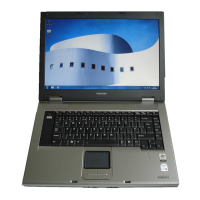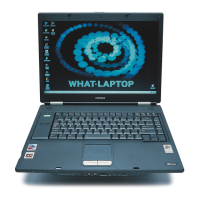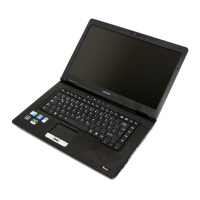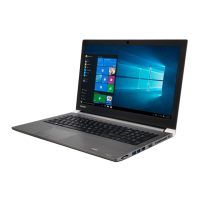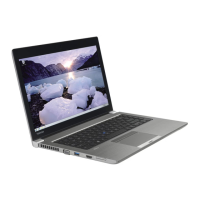Do you have a question about the Toshiba Tecra A2 and is the answer not in the manual?
Lists trademarks of Intel, Microsoft, and Eastman Kodak used in the manual.
States that the manual is validated for accuracy but subject to change without notice.
Information regarding the device's compliance with FCC rules and operational conditions.
Product compliance with European Directives and CE-Marking responsibility.
Technical regulations for modem use in Japan, including region selection.
Details on modem service type, telephone company procedures, and problem handling.
Warning about modem compliance with Austel standards in Australia.
Guide to unpacking and verifying included computer hardware components.
Lists preinstalled software, computer features, and available optional devices.
Identification of computer components from various views (front, sides, back, underside).
Explanation of system indicators, optical drives, and various computer ports.
Guidance on setting up a comfortable and safe workspace for computer use.
Steps for installing the battery, connecting power, and initial power-on.
Instructions for using the Touch Pad, USB floppy drive, and optical media drives.
Information on connecting, configuring, and using the modem and network interfaces.
Guidelines for cleaning, moving, and maintaining the computer.
Details on keyboard types, function keys, and special Windows keys.
Explanation of hot keys for system functions and keypad overlay operation.
Information on battery types, charging, safety precautions, and extending life.
Details on computer startup modes, passwords, and power management features.
Overview of the HW Setup utility for configuring hardware and system settings.
Procedures for managing passwords and setting boot device priority.
Details on installing memory, PC cards, and connecting peripherals.
Instructions for connecting monitors, printers, and port replicators.
Guidelines for diagnosing problems, preliminary checks, and system analysis.
Troubleshooting steps for hard drives, optical drives, modem, and network issues.
Technical details on physical dimensions, environmental requirements, and modem specs.
Explanation of the display controller and supported video modes.
Reference for essential AT commands used for modem control and configuration.
Details on S-registers for modem configuration, including auto-answer and escape characters.
Information on V.90 modem technology, speeds, and specific AT commands.
Step-by-step instructions for installing and removing the internal modem.
Specifications for wireless LAN cards, including compatibility and radio characteristics.
Details on AC power cord requirements and relevant certification agencies.
Table detailing computer configurations based on CPU, LCD, memory, and module bay.
Definitions of essential technical terms, components, and concepts used in the manual.
Lists trademarks of Intel, Microsoft, and Eastman Kodak used in the manual.
States that the manual is validated for accuracy but subject to change without notice.
Information regarding the device's compliance with FCC rules and operational conditions.
Product compliance with European Directives and CE-Marking responsibility.
Technical regulations for modem use in Japan, including region selection.
Details on modem service type, telephone company procedures, and problem handling.
Warning about modem compliance with Austel standards in Australia.
Guide to unpacking and verifying included computer hardware components.
Lists preinstalled software, computer features, and available optional devices.
Identification of computer components from various views (front, sides, back, underside).
Explanation of system indicators, optical drives, and various computer ports.
Guidance on setting up a comfortable and safe workspace for computer use.
Steps for installing the battery, connecting power, and initial power-on.
Instructions for using the Touch Pad, USB floppy drive, and optical media drives.
Information on connecting, configuring, and using the modem and network interfaces.
Guidelines for cleaning, moving, and maintaining the computer.
Details on keyboard types, function keys, and special Windows keys.
Explanation of hot keys for system functions and keypad overlay operation.
Information on battery types, charging, safety precautions, and extending life.
Details on computer startup modes, passwords, and power management features.
Overview of the HW Setup utility for configuring hardware and system settings.
Procedures for managing passwords and setting boot device priority.
Details on installing memory, PC cards, and connecting peripherals.
Instructions for connecting monitors, printers, and port replicators.
Guidelines for diagnosing problems, preliminary checks, and system analysis.
Troubleshooting steps for hard drives, optical drives, modem, and network issues.
Technical details on physical dimensions, environmental requirements, and modem specs.
Explanation of the display controller and supported video modes.
Reference for essential AT commands used for modem control and configuration.
Details on S-registers for modem configuration, including auto-answer and escape characters.
Information on V.90 modem technology, speeds, and specific AT commands.
Step-by-step instructions for installing and removing the internal modem.
Specifications for wireless LAN cards, including compatibility and radio characteristics.
Details on AC power cord requirements and relevant certification agencies.
Table detailing computer configurations based on CPU, LCD, memory, and module bay.
Definitions of essential technical terms, components, and concepts used in the manual.
| Chipset | Intel 855GME |
|---|---|
| Graphics | Intel Extreme Graphics 2 |
| Battery Life | Up to 3.5 hours |
| Wireless | Wi-Fi 802.11b/g |
| Processor | Intel Pentium M |
| RAM | 256MB - 2GB DDR SDRAM |
| Storage | 40GB / 60GB / 80GB HDD |
| Display | 15 inch XGA (1024x768) |
| Optical Drive | DVD-ROM / CD-RW combo drive |
| Operating System | Windows XP Professional |
| Weight | 2.8 kg |
| Dimensions | 329 x 270 x 36.8 mm (12.9 x 10.6 x 1.4 inches) |
| Ports | USB 2.0, VGA, parallel |

